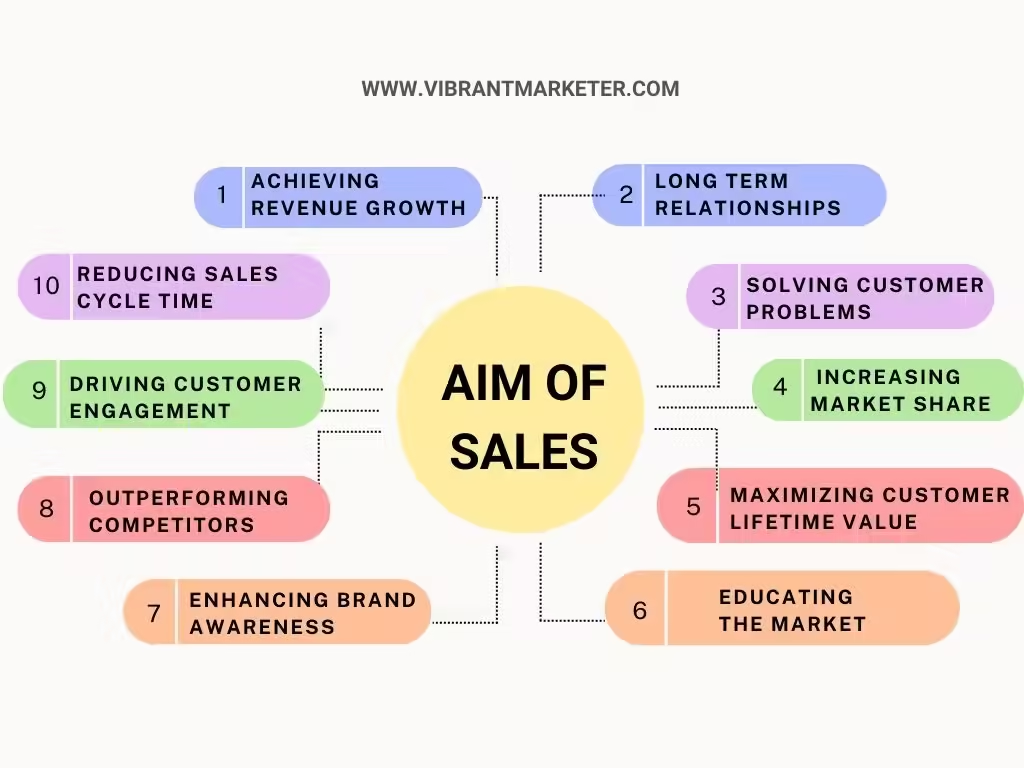What is the Aim of Sales? (10 Points to Know)


1. Achieving Revenue Growth
What It Is: One of the main aims of sales is to generate revenue by selling products or services. Without sales, a business cannot thrive, hire employees, invest in new technology, or grow.
Why It’s Important: Revenue growth is crucial for a company’s survival and success. It allows businesses to expand their operations, reach new markets, and innovate.
How to Do It:
- Focus on target markets that are likely to buy your product.
- Train your sales team to understand customer needs and showcase how your product meets those needs.
Example: A small bakery may aim to double its revenue by expanding its menu and reaching new neighborhoods through online delivery.
Case Study: When Apple introduced the iPhone, its goal was to achieve unprecedented sales growth by creating a revolutionary device. Apple’s aggressive sales and marketing efforts resulted in high revenue and changed the smartphone industry forever.
Expert Insight: “Revenue growth is not just about selling more—it’s about creating value and building trust with customers,” says Mary Barra, CEO of General Motors.
Tips for Achieving Revenue Growth:
- Track sales metrics and set achievable targets.
- Always ask customers for feedback and tailor future sales pitches accordingly
2. Building Long-Term Customer Relationships
What It Is: Sales isn’t just about one-time transactions; it involves building trust and loyalty with customers, encouraging them to return.
Why It’s Important: Loyal customers are more likely to make repeat purchases, refer new clients, and advocate for your brand, driving higher sales in the long term.
How to Do It:
- Provide exceptional customer service before, during, and after a sale.
- Personalize the interactions to make customers feel valued.
Example: Amazon focuses on building relationships by offering personalized product recommendations and easy returns. This encourages repeat purchases and customer loyalty.
Case Study: Zappos, an online shoe retailer, is famous for its customer service. Their sales team goes above and beyond, creating strong bonds with customers. As a result, many customers keep coming back.
Expert Insight: “If you focus on building relationships, sales will follow,” says Richard Branson, founder of Virgin Group.
Tips for Building Relationships:
- Follow up with customers after a sale to ask if they need help.
- Use social media to engage and respond to customer inquiries.
- Be transparent and honest about your products.
3. Solving Customer Problems
What It Is: Effective sales involve understanding customer needs and offering products or services that solve their problems or improve their lives.
Why It’s Important: Customers are more likely to make a purchase if they believe it will address their specific challenges or enhance their well-being.
How to Do It:
- Ask open-ended questions to uncover a customer’s true needs.
- Tailor your sales pitch to show how your product is the best solution.
Example: A salesperson at a hardware store might help a customer select the best tools for a home project by asking questions and offering advice tailored to their goals.
Case Study: Salesforce became a leader in the CRM market by understanding its customers’ pain points—complex and expensive software—and providing a cloud-based solution that simplified the process.
Expert Insights: “To sell well, you need to listen well. Understand the customer’s challenges, and your product can become the perfect solution,” says Satya Nadella, CEO of Microsoft.
Tips for Solving Problems:
- Use active listening to understand customer concerns.
- Provide demos or free trials to show how your solution works.
- Offer guarantees or warranties to build confidence.
4. Increasing Market Share
What It Is: Sales aims to increase a company’s market share by gaining a larger percentage of total sales within an industry.
Why It’s Important: A larger market share strengthens brand recognition, increases influence, and often allows companies to achieve economies of scale.
How to Do It:
- Target customers who currently buy from competitors.
- Highlight the unique features or benefits of your products.
Example: Coca-Cola and Pepsi continuously battle to capture a larger market share in the beverage industry, using promotions and brand partnerships to win customers.
Case Study: When Samsung entered the smartphone market, it targeted Apple users by offering diverse models at different price points. This strategy allowed it to capture a significant share of the global market.
Expert Insight: “Winning market share is about meeting customer expectations and innovating faster than the competition,” says Sundar Pichai, CEO of Alphabet Inc.
Tips for Increasing Market Share:
- Offer competitive pricing and promotions.
- Introduce innovations that outshine competitor products.
- Focus on underserved markets.
5. Maximizing Customer Lifetime Value (CLV)
What It Is: Sales doesn’t just aim to generate individual transactions but to maximize the total value each customer brings over their lifetime.
Why It’s Important: Increasing CLV means higher long-term revenue from each customer without incurring high acquisition costs.
How to Do It:
- Upsell and cross-sell relevant products.
- Keep in touch with customers to nurture the relationship.
Example: Subscription services like Netflix focus on keeping existing customers engaged through new content, maximizing their lifetime value.
Case Study: Tesla continually updates its software for existing car owners, adding new features and improvements. This builds loyalty, increases value for the customer, and boosts repeat sales.
Expert Insight: “Repeat customers drive more profitability than one-time buyers,” emphasizes Jeff Bezos, founder of Amazon.
Tips for Maximizing CLV:
- Reward loyal customers with exclusive perks.
- Track customer behavior to make personalized offers.
- Regularly communicate updates or new products.
6. Educating the Market
What It Is: Sales also aims to inform customers about your products, market trends, and how your offerings stand out from competitors.
Why It’s Important: An informed customer is more likely to buy, especially if they understand the value of your product and how it solves their problems.
How to Do It:
- Host webinars or workshops to explain product benefits.
- You can provide informative content on your website and social media platforms
Example: A software company might create detailed guides and training sessions to show potential customers how to use their tools effectively.
Case Study: HubSpot, a marketing software company, offers free educational resources, webinars, and certifications. This has helped them attract customers and build credibility in the market.
Expert Insight: “An educated customer is an empowered one who is more likely to trust and purchase from you,” says Sheryl Sandberg, COO of Meta.
Tips for Educating Customers:
- Use videos and infographics for easier understanding.
- Engage in Q&A sessions with potential customers.
- Share real-world success stories and testimonials.
7. Enhancing Brand Awareness
What It Is: Sales activities often contribute to spreading awareness about a brand’s existence, values, and offerings. This means making sure that people recognize and remember the company and its products.
Why It’s Important: Increased brand awareness makes it more likely that people will think of your business first when they need a product you offer. It builds trust, attracts new customers, and helps maintain relevance in the market.
How to Do It:
- Create compelling sales presentations that emphasize your brand’s story.
- Leverage social media and sales events to reach a wider audience.
Example: Sales representatives for Nike often showcase the brand’s commitment to performance and style when promoting new shoes, helping keep the brand top-of-mind for athletes.
Case Study: Red Bull’s sales efforts, combined with their high-profile event sponsorships, have made their brand synonymous with energy and extreme sports.
Expert Insight: “Brand awareness is a powerful tool to engage customers and build loyalty,” says Indra Nooyi, former CEO of PepsiCo.
Tips for Enhancing Brand Awareness:
- Collaborate with influencers or partner with well-known brands.
- Provide samples or run giveaways to introduce your products.
8. Outperforming Competitors
What It Is: One aim of sales is to outperform competitors by capturing a larger share of the market, offering superior products, or providing unmatched customer service.
Why It’s Important: Staying ahead of competitors ensures long-term growth, better profits, and a solid industry reputation. It also reduces the risk of losing market relevance.
How to Do It:
- Study competitors’ strengths and weaknesses.
- Focus on delivering better customer experiences and innovative products.
Example: When Amazon began offering faster shipping options, they outperformed competitors and attracted more customers due to the convenience.
Case Study: Samsung often outperforms competitors by quickly adopting new technologies and offering a wide range of smartphone models at various price points.
Expert Insight: “Businesses must evolve faster than their competitors to win in today’s market,” says Elon Musk, CEO of Tesla and SpaceX.
Tips for Beating Competitors:
- Gather feedback from customers to understand market needs better.
- Invest in innovation and keep updating your offerings.
- Provide better customer support and after-sales service.
9. Driving Customer Engagement
What It Is: Sales aims to actively engage with customers, making them feel involved with the brand through meaningful conversations, support, and follow-ups.
Why It’s Important: Engaged customers are more likely to stay loyal, make repeat purchases, and become brand advocates. Engagement leads to stronger relationships and better customer satisfaction.
How to Do It:
- Use social media and email marketing to interact regularly with customers.
- Host events, webinars, or loyalty programs to maintain customer interest.
Example: Starbucks uses its rewards program to keep customers engaged through personalized offers, free drinks, and special events.
Case Study: LEGO involves its community by allowing fans to submit their own set ideas through the LEGO Ideas platform, creating a strong bond between customers and the brand.
Expert Insight: “Engagement starts with listening and responding to your customers’ needs,” says Brian Chesky, CEO of Airbnb.
Tips for Driving Engagement:
- Regularly share educational or entertaining content.
- Encourage customer feedback through surveys and reviews.
- Reward loyal customers for their continued support.
10. Reducing Sales Cycle Time
What It Is: Another aim of sales is to shorten the time it takes to close a sale, ensuring that customers can make purchasing decisions faster without getting stuck in long sales processes.
Why It’s Important: Shorter sales cycles reduce costs, improve productivity, and allow sales teams to serve more customers efficiently. It also increases customer satisfaction since they experience a smoother process.
How to Do It:
- You can use the data and analytics to target the right customers with relevant offers.
- Train sales teams to identify and overcome customer objections quickly.
Example: A car dealership may offer “one-day purchase” promotions, where they streamline paperwork and financing to make the sales process as fast as possible.
Case Study: HubSpot, a leader in marketing and sales software, uses automated workflows and targeted lead scoring to help its sales teams close deals faster.
Expert Insight: “Reducing the sales cycle is about understanding customers’ needs and removing obstacles,” says Marc Benioff, CEO of Salesforce.
Tips for Reducing Sales Cycle Time:
- Provide clear product information and answer common questions upfront.
- Follow up promptly with leads and address concerns without delay.
- Use CRM tools to automate parts of the sales process.
Conclusion: What is the Aim of Sales
FAQs
The main goal of sales is to sell products or services to customers by meeting their needs and building strong relationships, helping businesses grow.
Sales are essential for a company because they bring in revenue, help expand customer bases, and build the brand’s reputation.
By understanding and solving customer problems, salespeople ensure customers are happy, which builds loyalty and encourages repeat business.
Sales teams promote the company’s products and values, helping people remember and trust the brand.
Sales teams outperform competitors by offering better customer experiences, providing unique solutions, and staying ahead with new products.
It means keeping customers interested and involved with your brand through regular interactions, offers, and personalized support.
Yes, by understanding customer needs, offering the right solutions, and removing obstacles, sales teams can make purchases faster and easier.
Targets give salespeople clear goals to achieve, helping them stay motivated and focused on boosting the company’s success.
Successful salespeople are good communicators, problem-solvers, and they understand their customers’ needs.
Share this post
















